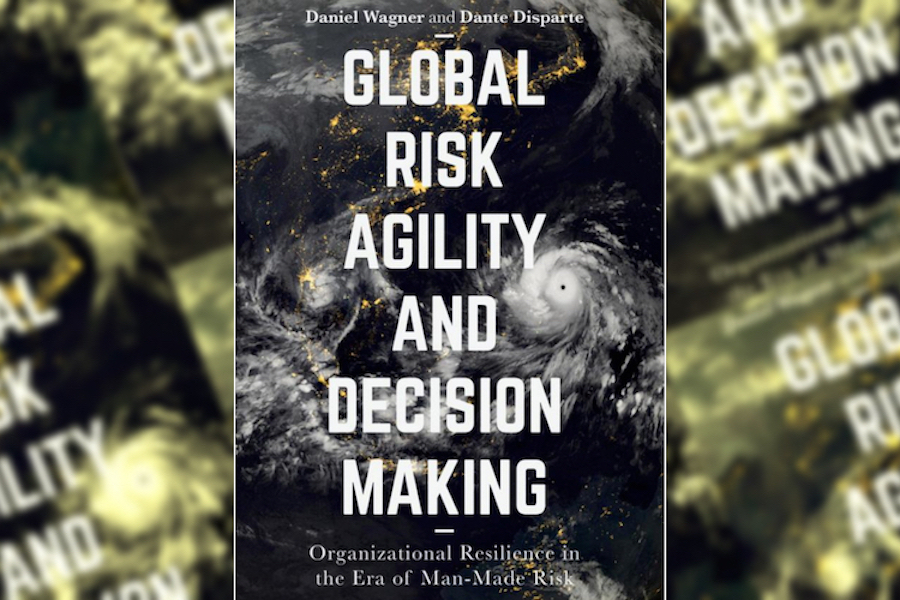
Books
How to Understand Risk Management and Decision Making
Global Risk Agility and Decision Making is truly a book for the 21st century, tackling a variety of cutting edge topics many of us are not necessarily focused on – both in the context of business and our own lives. Daniel Wagner and Dante Disparte have successfully identified and tapped into the implications of the clash between natural and man-made risk, and the necessity of getting out ahead of it.
The authors take us on a wild ride – a combination of 21st century current affairs, advanced risk management practice, and the rising importance of having a moral compass – to produce a work that should prove to be timeless.
The book’s introductory chapter takes the reader on a global tour of hot spots and problems that confront us, setting the stage for what is to come, and reminding us that despite all the resources devoted and money spent to start to address such risks as pandemics and terrorism, we have in many respects barely dented the surface.
The second and third chapters cover the importance of thinking about risk management as a process and a source of value addition, rather than simply being considered a traditional cost center or check list along the way to obtaining internal corporate approval to make investments or achieve a modicum of organizational resilience. The third chapter, in particular, is filled with excellent current examples of challenges we face at an organizational, municipal, national, and global level. Chapters four and five round out the first third of the book, and discuss the importance of achieving complexity reduction and the right balance between the profit motive and a risk agile corporate culture.
The heart of the book, its middle third, drills down into the core 21st century man-made risks of terrorism, climate change and cyber-risk. Chapter six, which focuses on terrorism, provides rich examples of misperceptions most of us have about what terrorism is and is not, why it occurs, where it occurs, and what can be done about it. Chapter seven addresses the rising importance of economic nationalism, providing compelling examples of the diverse contexts in which it occurs. Chapter eight, on climate change, encourages us to think more deeply about why humanity must stop the inexorable rise of global warming as quickly as possible, and provides stark information from some of the world’s most authoritative information sources about what may happen in many of our lifetimes if we fail to do so.
For those who have not yet personally experienced being hacked at home or at work, chapter nine provides plenty of food for thought. The costs associated with cyber-crime and cyber-hacking are rising by the month, with increasingly perilous outcomes for our infrastructure, elections, and commerce.
The authors help us understand the true severity of the problem, and what can be done about it. Chapter ten, on corporate social responsibility, provides a fresh take on how CSR fits into the global commercial landscape, and how consumers increasingly reward those companies that demonstrate sensitivity to CSR, and punish those that do not. The chapter on country risk management is a good primer on the subject, balanced between theory and practice to give the reader a foundation from which to delve deeper into the subject, and putting it into the larger risk management context.
The final third of the book concentrates on how to achieve effective decision making in the context of the clash between natural and man-made risk. Chapter twelve dives into what the authors call ‘transactional risk management,’ or viewing each transaction as having its own ecosystem, and deserving to be treated as such. Chapter thirteen, anticipatory risk management, discusses how to transition away from enterprise-wide risk management and introduce a moral compass into the decision making process in order to make the right choices and stay ahead of the curve. Chapter fourteen addresses how to achieve meaningful risk governance in the context of man-made risk. The final chapter, fifteen, puts into focus how to make sense of it all, combining real world examples of ongoing issues on a micro and macro level with some common sense prescriptions, such as looking beyond the news headlines, integrating as many people as possible into the decision making process, and simply doing the right thing, which can in many cases be the missing ingredient for success.
The book’s title is wholly appropriate for this weighty tome. The reader is guided through the maze of daunting daily global operational business challenges and taken through a rigorous analytical thought process to arrive at a common sense conclusion: organizations that wish to survive and thrive in the era of man-made risk really have no choice but to change the way they think about the world, and the way they will manage the plethora of risks – known and unknown – going forward. Global Risk Agility and Decision Making should be a considered essential reading for anyone who wishes to contribute to solving risk management dilemmas in the 21st century.

